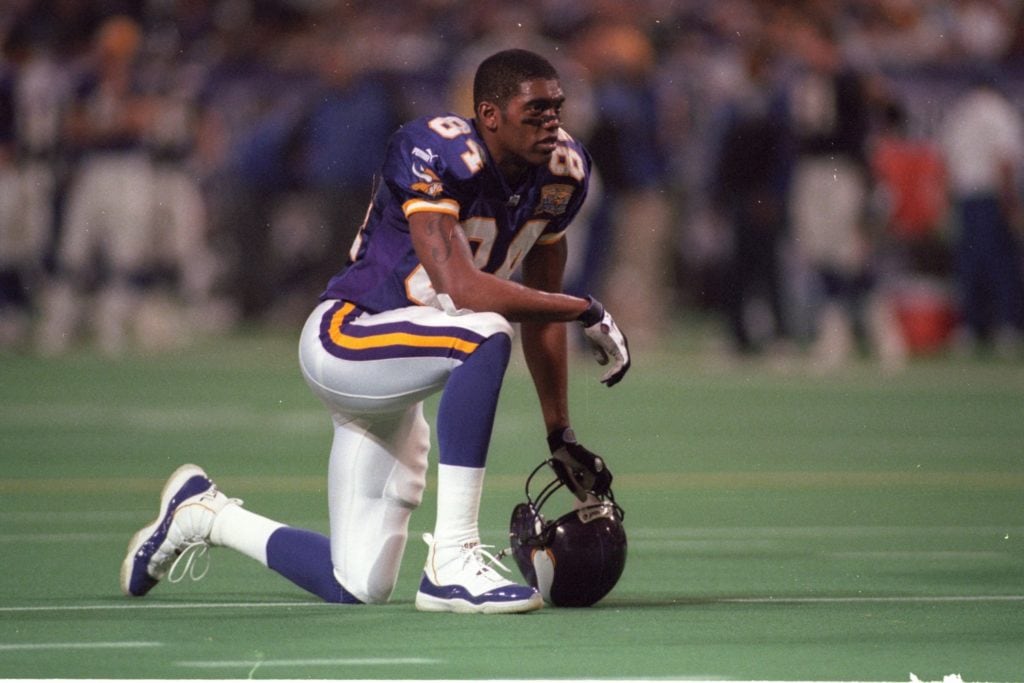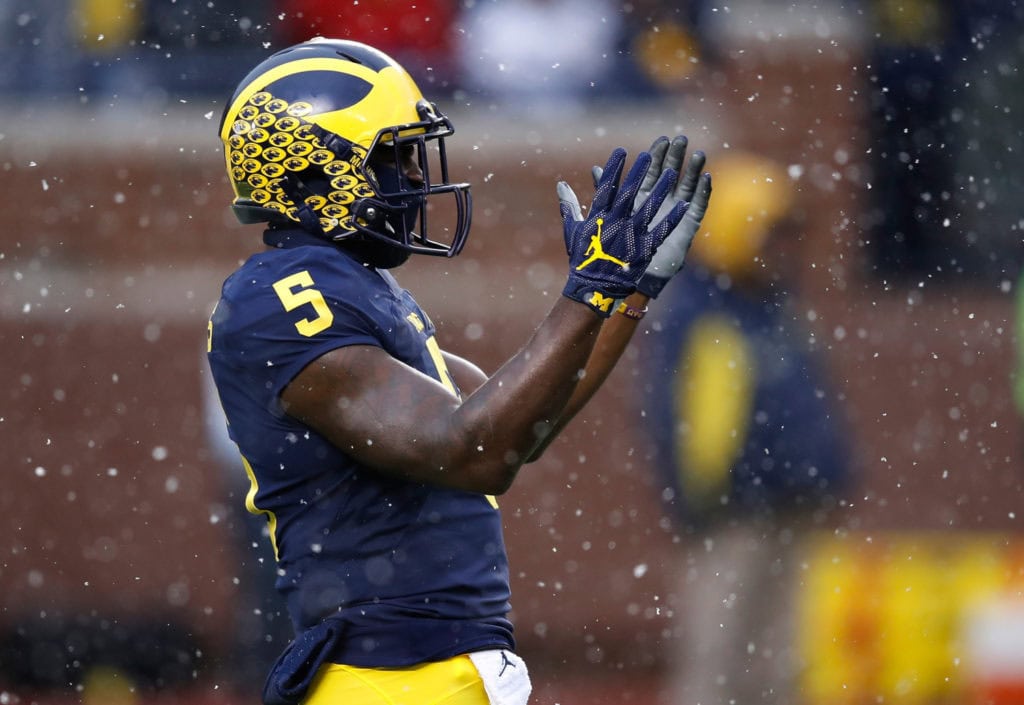An array of NFL talent and NCAA powerhouses sport the iconic Jumpman logo on the gridiron. Just how and why did Michael Jordan’s namesake company decide to invest in football?
Michael Jordan and Nike announced the Jordan Brand 25 years ago in New York City.
Appearing on The Rosie O’Donnell Show and hosting a runway presentation, young NBA talents like Eddie Jones and Ray Allen were introduced as early endorsers while musicians like Q-Tip and Blackstreet modeled the Jumpman’s first fall line. Having held a firm grip on hoops and street fashion for over a decade, the larger looming plan was to take over territories beyond basketball.
In 2022, Jordan Brand has staked a claim in sports, culture, and fashion wider than MJ or Phil Knight could’ve dreamt. Pulling in $3M in sales every five hours, the Jumpman empire has expanded from sponsoring the Cincinnati Bearcats basketball team to outfitting Paris Saint-Germain. By aligning with Mike’s mission, the likes of Travis Scott, Billie Eilish, and Virgil Abloh have all made JB relevant among a young audience.
Despite all that energy at boutiques and abroad, Jordan Brand has bet big domestically on a sport Mike hasn’t played since high school: football.
Over the last quarter century, MJ taking over the gridiron is something few could have forecast, but is a telling tale in Jordan’s expansion strategy. Following the signing of 49ers wide receiver Deebo Samuel, see how Jordan Brand has gone all in on football.
All-Pro Personalities
In the beginning, Jordan Brand’s basketball business was building a roster that mirrored MJ’s polished profile. In football, their strategy was quite the opposite.
To begin their gridiron quest, Jordan Brand got loud in 1999 by signing Randy Moss as their first NFL endorser.
After falling in the 1998 NFL Draft due to controversy clouding his college career, Moss quickly proved spectacular on Sundays. Already playing on AstroTurf in Minnesota, JB gave Randy everything from team-toned retro releases to his own signature shoe.
While Moss was a guinea pig in having his own marquee model of trainer and cleat, he was proof of concept when it came to the type of players they’d soon sign.

Entering a new millennium, Jordan Brand expanded its NFL roster to include Warren Sapp, Donovan McNabb, and Terrell Owens.
Each athlete exemplified the greatness associated with Mike’s moniker while providing electricity to connect to a somewhat foreign fan base. While MJ was non-native to the football field, having players that would consistently pop up in highlights and in conversation kept the brand hot as it looked to expand.
For most of the early ’00s, Jordan Brand athletes would add energy to retro products in cleated form on the field while often modeling the brand’s emerging Lifestyle line off of it. As JB leaned into training and fashion, football players provided the perfect platform to demonstrate toughness in both categories.
Now that Michael was retired from basketball, it was time for his company to sell performance products for another market.
Foot in the Game
For years, Jordan Brand NFL stars lived in rarified air as the only athletes given access to Air Jordan cleats. Eventually, that tide changed.
By the mid ’00s, catalogs such as Eastbay began to stock Air Jordan cleats. Serving as the premier place to buy football footwear, the Wisconsin-based company carried an Air Jordan retro cleat almost annually in basic Black/White and White/Black blocking.
Early entries included the Air Jordan 12, Air Jordan 14, and Air Jordan 3. Even hardwood favorites like the Air Jordan 6 were modified in cut and traction for gridiron versatility. Attracting sneakerheads who played high school football, Jordan Brand bridged a gap between the pros and their amateurs admirers.
No longer were retro cleats a rarity reserved for Charles Woodson or Marvin Harrison. Rather, any linebacker with enough lawn mowing money could play their whole senior season in them.
However, one major piece of the puzzle was still missing.
Back to School

In its infancy, Jordan Brand made its biggest branding mark by outfitting college basketball clubs like Cincinnati, Cal, St. John’s, and North Carolina A&T. It was a point of pride for Jumpman schools as well as a living legacy of Mike’s major accomplishments.
In the ’00s and 2010s, sponsors shuffled, with Jordan eventually acquiring North Carolina, Georgetown, San Diego State, and Marquette. The schools signed were mostly a means to leverage pre-existing relationships, connecting active endorsers to their alma maters.
When deciding to cross over into the big-money world of college football, the moves were much more calculated.
In 2015, the University of Michigan signed on as the first school to endorse the Jumpman in football. Ending an Adidas deal and having just brought on a famous alum in Jim Harbaugh as head coach, the Wolverines were oozing with energy at the time of the news.
Not only did the off-kilter collaboration cut through, it provided a runway for a retail surge once unveiled in Fall 2016.
“Michigan was a perfect match for what they represent and what we brought to the table,” Larry Miller, Jordan Brand chairman, told Boardroom in Jan. 2022. “The first weekend that we launched, MJ and all of us were out there. On that weekend, they sold more products at the bookstore than they had the whole year before.”
That same season, MJ named his alma mater, the North Carolina Tar Heels, the second college football Jordan school. While it may have seemed like deja vu all over again in regard to relying on relationships, there were always loftier ambitions.
Combining the regionally focused foundation of Jordan Brand’s late ’90s entry into college basketball with their bigger picture vision of endorsing powerhouse programs like Michigan, Mike’s empire has spent the last few years going all in.
By signing football deals with Oklahoma, Florida, and UCLA, Jordan Brand continues to align with teams associated with greatness. Additionally, they’re building on storied tradition while advertising all Fall on national television.
“When the Michigan deal happened, that opened up the idea of Jordan Brand on the football field,” Miller said.
Since then, the sky has been the limit.
Sunday Spotlight
While Jordan has endorsed NFL athletes for almost a quarter century, getting the Jumpman logo on gameday apparel took years.
For the better part of two decades, JB outfitted All-Pro endorsers in calculated colorways of the Air Jordan 3, Air Jordan 11, Air Jordan 12, and Air Jordan 13.

The styles weren’t necessarily driven by what was released on the market or what would make a great football cleat. Rather, said shoes carried such recognizable blocking that fans from afar could identify the cleats as Air Jordans even if they weren’t branded.
Due to the NFL’s costly barrier of entry for logo visibility — the reason Tom Brady has been playing in unbranded Under Armour cleats for the past two seasons — Mike and company did not find it feasible to pay for placement.
In 2018, that all changed when they finally paid to have the Jumpman shown on NFL cleats.
Quickly, Jordan Brand invested in an array of athletes on short-term deals. Stars like Le’Veon Bell, Earl Thomas, Tyrann Mathieu, Jimmy Garoppolo, and Jalen Ramsey were all wearing retro cleats on Sundays.
Doubling down, more models were suddenly available at retail.
Over the course of recent seasons, Jordan Brand has not only dressed top talent in iconic colorways of the Air Jordan 1, Air Jordan 10, and Air Jordan 11 on the field, they’ve made those styles available for public consumption.
Now athletes from Pop Warner to the Super Bowl can play in pairs once exclusive to Randy Moss.
Some suggest that Jordan’s big leap into football came as a piece of Nike’s larger goals. In 2015, then CEO Mark Parker set the intention for Nike, Inc. to reach $50B in revenue by 2020. In order for Jordan Brand to do its part, it had to multiply its already booming business.
Never afraid to place a phone call, MJ and his company have dived headfirst into the high-stakes sport of football. It makes one wonder what’s next.
Will more NFL stars sign on with Mike? Is another college contract in the works? Will NFL jerseys someday sport the Jumpman logo?
If history is any indication, the conversations are already underway.
Read More:
- For Mark Jackson, Christmas Day at Madison Square Garden Still Hits Different
- The 25 Best Movies of 2025: ‘Sinners’, ‘Friendship’, ‘Secret Mall Apartment’, and More
- Austin Ekeler’s Netflix NFL Analyst Role Previews Potential Post-Career Plan
- ‘It: Welcome to Derry’ Shows How Stephen King’s Universe Can Finally Interconnect
- Cam Ward Reveals His Mount Rushmore of Kevin Durant, Tom Brady, Kobe Bryant & More